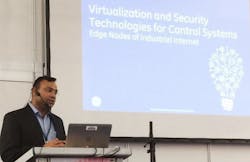Will Controllers Become Part of Edge Nodes?
It may seem like a heretical concept, but the idea of moving the controller from its place in the heart of an automated system to component status in a machine gateway that performs numerous other functions is not some future factory idea. The enabling technology is here today and the movement is already underway.
During a discussion with Vibhoosh Gupta, general manager of controls platforms at GE Automation and Controls, he explained that, to understand this shift, it helps to view it from the vantage point of the cell phone technology evolution we’ve all been a part of.
“If you look at what’s happened with cell phones,” Gupta said, “starting with the 2007 introduction of the iPhone, the cell phone stopped being just a phone and became a human gateway—an edge node” on which users run a variety of apps.
In GE’s approach to industrial edge nodes, Gupta said, “We don’t differentiate between the app on the device or in the cloud—much like with Apple Music, the app is on the phone, but the music is in the cloud.”
If this concept seems a bit difficult to grasp in an industrial context, consider that even Steve Jobs didn’t initially imagine that the iPhone would become a camera, GPS device, credit card terminal, electronic bank and digital wallet, Gupta said.
It is from this point of view that Gupta explains why controllers will likely become features of edge nodes rather than separate devices as they have historically been. “In the near future, customers won’t buy a controller,” he said. “They’ll buy an edge node that provides security and cloud connectivity for the machine that also includes a controller.”
According to Gupta, the three key facets of an industrial Internet edge node that could also house a controller, are:
* Virtualization: Multicore virtualization allows you to do more work without increasing clock speed while keeping the device under the thermal envelope.
* Connectivity: To be intelligent, machines need to be connected. He noted that the impressive extent of Watson’s abilities don’t stem from its built-in capabilities as much as it does from its Internet connectivity.
* Security: Though industry’s level of comfort when it comes to connecting industrial devices to the Internet has grown, embedded hardware levels of security are a must. Edge node chips should all be Trusted Platform Modules to create a hardware-based loop of trust. (See “Consumer Embedded Security in Industry”).
Two years ago, in its white paper “The Virtualization of Control in the Era of Software Defined Machines,” GE noted “The capability to collect and analyze data is at our fingertips in the Industrial Internet era. However, a different architecture is required to take advantage of these possibilities—an architecture with seamless connection between the actual equipment, the people interacting with this equipment, and advanced analytics generating insights to maximize the efficiency, life, and effectiveness of this equipment.”
The company’s approach with edge nodes is a logical next step on the virtualization path explained in this paper.
“We have [already] created a trillion-dollar worldwide economy by connecting 7 billion humans to the Internet,” Gupta said. “Imagine what will happen when 50 billion devices connect. Industrial apps will be developed tomorrow that we can’t even imagine today; new business will be launched from this platform that we haven’t even envisioned yet.”
About the Author
David Greenfield, editor in chief
Editor in Chief

Leaders relevant to this article:
